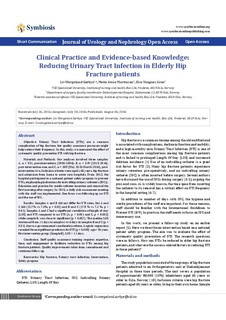| dc.description.abstract | Objective: Urinary Tract Infections (UTIs) are a common
complication of hip fracture, but quality assurance processes might
help reduce their frequency. In this study, we measured the effect of
systematic quality prevention UTI with hip fracture.
Materials and Methods: Our analyses involved three samples:
A, n = 331, pre-intervention (2004-2006); B, n = 319 (2013-2014),
post-intervention one; and C, n = 349 (May 2015-March 2016), postintervention
two. Inclusion criteria were aged ≥65 years, hip fracture
and admission from home to acute care hospitals. From 2012, the
hospital participated in a national patient safety program to prevent
UTIs, emphasizing indications for indwelling urinary catheters (IUCs).
Education and practice for sterile catheter insertion and removal the
first morning after surgery. In 2015, a daily risk-assessment meeting
with the staff was implemented. One focus was following up on UTI
and the use of IUC.
Results: Samples A and B did not differ for UTI rates, but A and
C did (12.7% vs 7.2%; p = 0.02) and B and C (17.9 % vs 7.2 %; p <
0.01). Samples A and C had a significant correlation of length of stay
(LOS) and UTI compared to no UTI (A, p < 0.001 and C, p = 0.002)
while sample B, was close to significant (p = 0.057). The median LOS
decreased from 11 days in sample A to 6 days in samples B and C (p =
0.01) due to a governmental coordination reform. Logistic regression
revealed three significant predictors for UTI (p = 0.000): age > 81 year,
first intervention group (Sample B), LOS > 11 days.
Conclusion: Staff quality assurance training requires expertise,
time, and engagement to facilitate reduction in UTIs among hip
fracture patients. Quality improvement takes time, commitment and
continues follow up. | nb_NO |
